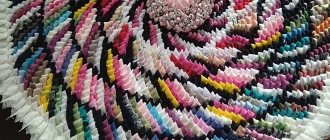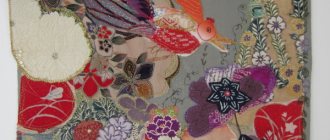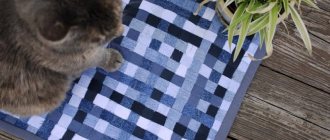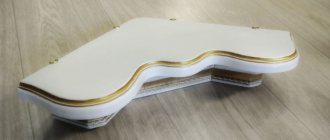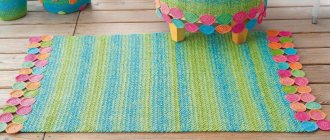Scraps and remnants of various fabrics are not garbage, but a real treasure in the hands of a needlewoman, which can be turned into amazingly beautiful and useful things, for example, rugs for a nursery, hallway or bathroom. There are so many ways to make rugs and rugs that you don’t even need to know how to sew and knit, you just need to choose the most convenient option for yourself.
DIY rugs made from scraps of fabric
After getting acquainted with the methods of making chair covers and sewing rugs, think about whether it is worth throwing away old T-shirts, jeans, towels, woolen sweaters and scarves. After all, all these things, even if they are shabby, with holes, faded in the sun, can be given a second life.
Patchwork fantasies
Bright rainbow rug
Preparation of flaps
Depending on the chosen technique for making the rug, scraps of fabric of different sizes and shapes may be required. It is better to select and cut the required amount in advance so as not to be distracted while working.
Preparing long strips of fabric for knitting or weaving a product can cause some difficulties: sewing them together is a long and tedious job. And if you tie them in knots, the rug will turn out rough and sloppy. But there are ways to avoid this.
Cutting continuous tape
This method is used when preparing fabric strips from old clothes: T-shirts, turtlenecks, T-shirts and even tights.
Step 1.
We cut off the rough bottom seam, the cuff of the sleeve or the toe part of the tights.
For a T-shirt or turtleneck, cut off the top part right below the armholes. Trimming seams
Step 2.
Place the product on a flat surface with the side seam facing you and cut it into strips of the required width, without cutting a couple of centimeters to the opposite seam.
Cutting strips
Step 3.
Thus, we cut the entire workpiece into fringe.
Cutting the workpiece
Step 4.
We straighten the workpiece so that we can see the entire uncut part, and cut it not in a straight line, but at an angle, directing the scissors from one slot to the adjacent one on the other side of the product.
Cutting through the fabric
As a result, we get a closed ring, which to obtain a tape you just need to cut across one of the seams.
Blank for making a rug
Blanks can be wound into balls
Connection without node
If the length of the tape is not enough or you need to connect many short pieces with each other, the simple technique shown below will help you do this.
| Image | Description |
| Step 1 | We cut small holes at the ends of adjacent strips that need to be connected. |
| Place the strips on top of each other, aligning the slots. |
| Step 3 | Pass the second end of the top strip through the slot from below and pull the entire strip through it. |
| Step 4 | Tighten the connection. If necessary, repeat these steps to further lengthen the tape. |
Advice. If scraps of fabrics of different thicknesses and densities are used, then thinner ones should be cut into strips of greater width to even out the thickness of the weaving.
Rug woven from braids
To create a rug you will need:
- fabric base according to the size of the future product;
- pieces of different fabrics or old clothes;
- scissors;
- needle and thread (you can use a sewing machine);
- fabric glue;
- wide tape.
Progress:
- Cut the fabric into long strips, each 6–7 cm longer than the longest side of the rug.
- Gather the ribbons into bundles of 3 strips and braid them into pigtails, leaving free ends on both sides (secure the edges of the blanks with tape to prevent them from unraveling).
- Apply glue to the fabric base.
- Carefully glue the braids onto the base.
- Sew the rug from the narrow sides using a sewing machine or by hand.
- Remove the tape and trim the ends so they are even.
Knitted rugs from patches
From scraps joined into long ribbons, a rug can be crocheted, just as napkins are crocheted from ordinary yarn. True, for such work you need a large hook, 6-10 mm thick.
Begin work by tying a braid of 5-6 air loops, which are closed into a ring. Then the fabric is knitted in a spiral with double crochets, periodically knitting two stitches from one loop to increase the diameter. After each row, the work must be laid out on a flat surface to control the plane.
Crochet
Crocheting a rug
Video - Crocheting a round rug from cut fabric strips
Such a simple round rug does not require any special skill; even those who have picked up a crochet hook for the first time can knit it. If you have experience, you can create real masterpieces of any form.
Crochet rug Handmade children's rug Bright knitted rug
Multicolored rug
Patchwork - what is it?
The name of this technique (Patchwork) comes from the English language. If we translate this concept literally, we get “sewing from scraps.” As a matter of fact, the name fully explains the feature and method of production of this product.
According to historical information, the origin of this technique occurred many centuries ago. Evidence of this is the exhibits of Cairo museums. There you can see patchwork quilts once made by Egyptian women. Another valuable exhibit is a patchwork kimono kept in the Tokyo Museum. Archaeologists believe that the approximate time of manufacture of this find is the 9th century BC. e.
The revival of patchwork occurred many centuries later in European countries. Since then, the popularity of handmade bedspreads and carpets has not decreased.
Braided rugs
You can weave a rug in different ways, and to do this, the scraps again need to be joined into long strips.
Braid rug
This method is very simple, it does not require any tools or equipment other than a needle and thread.
Step 1.
Sew three patchwork strips together.
Sew three patchwork strips together
Step 2.
We braid them into a regular braid. It should turn out to be quite long, so the strips will have to be extended as you work.
Braiding
Step 3.
We secure the end of the braid with a pin and begin to roll it in a spiral on a flat surface.
Twisting the braid
Step 4.
We fasten each turn to the previous one on the reverse side, sewing it with threads.
Sewing the braids
Step 5.
You can do it differently: first twist the entire braid, and then carefully sew the turns in a spiral.
Making a rug
An oval rug is made in the same way.
Braided braided rug Terry braided rug
Curly rug made from braids
Rug made of towels
But if you need a rectangular shape, it is better to weave several braids of the same length, lay them close to each other and sew them in a straight line. And weave the ends with cord or sew on a typewriter.
Scheme for making a rectangular rug
Rectangular woven rug
Advice. Such a rug will hold its shape better if you add a lining to it on the back side.
The lining can be an old towel
Braided rug
To make such a rug you need to make a frame for weaving. Its size should be slightly larger than the desired size of the canvas. Nails with small heads are placed on two opposite sides or wooden pins are installed to secure the base. The distance between them is 2-2.5 cm.
Weaving frame
Advice. If you add another intermediate crossbar to the frame, which can be attached at different levels, you can make rugs of different sizes.
Step 1.
We begin work by securing the warp threads.
This can be cord, twine, thick yarn, or scraps tied into a long ribbon. The end of the tape is tied to the upper corner stud, after which it is snaked around all the pins of the upper and lower crossbars in turn. You need to stretch the base well, but not too tightly. Attaching the warp threads
Step 2.
Preparing working threads.
They should not be too long so as not to make weaving difficult. It is better to attach the next strip as you shorten the previous one. Preparing working threads
Step 3.
We begin weaving by alternately passing a strip of working thread over and under the stretched warp threads.
Let's start weaving
Step 4.
Having reached the end of the row, we wrap the working thread around the outer warp thread and continue weaving in the other direction.
Weaving from the edge
Step 5.
Every few rows, compact the fabric by pulling the woven rows up.
To do this, you can use a special device in the form of a wooden fork or simply use your hands. The denser the weaving itself and the smaller the distance between the rows, the less noticeable the warp threads will be. Device for compacting threads
Step 6.
We make the required number of rows, periodically increasing the working thread or changing it to a strip of a different color.
Weaving a rug
Step 7.
If the color of the working thread needs to be changed at the edge of the rug, it is cut close to it and hemmed, or the next strip is tied to the cut end, and the knot is left on the wrong side. But you can do it differently: tie the strips on the edge, leaving long tails. In this case, the edges of the rug will be fringed.
Weaving a rug with fringe
For reference. The fringe on the other two sides can also be done at once, if you do not wind the warp threads around the pins, but tie them to each pair with separate strips.
Cape with fringe for a chair.
When finished, the fabric is carefully removed from the nails.
You can complicate the weaving by taking two working threads instead of one at once, and interweaving them both with each other and with the warp threads.
How to weave a rug without a loom
Video - Rug made of shreds on a frame
You can also weave a round rug in a similar way. A hoop can serve as a frame for it.
Round woven rug The process of weaving a rug on a hoop
Stitching
It is most convenient to first connect the squares into separate strips. They do it as follows.
- Fold 2 squares with the right side inward and stitch on one side (0.5 cm should be removed from the edge). The seams are immediately ironed.
- One of the squares is connected to the 3rd front side inward. It is necessary that the stitching results in a stripe. The seam is ironed (this procedure is repeated after each stitching).
- The striped squares continue to be sewn until the length reaches the width of the rug.
- All other squares are connected into strips according to the same pattern, the seams are ironed.
- The finished strips are connected together into a large web.
- The fabric for the wrong side and the padding polyester are folded together and stitched. It turns out to be a lining. It and the patchwork rug are also placed right sides together. The edges are sewn together using a machine, leaving a small hole through which the product can be turned out.
- The remaining hole is sewn on the front side. You can do this manually. To make it more invisible.
A do-it-yourself rug made from scrap triangles is made according to the same principle, only before this the triangles are sewn into squares and then into strips.
Knotted rug
To make such a shaggy rug, you don’t need to sew the scraps into ribbons. They just need to be cut into strips 8-12 cm long, depending on how long the “pile” you want to get.
In addition to them, the work will require a crochet hook and a special mesh for carpets, which can easily be replaced with a synthetic construction mesh. The base of the desired shape and size is cut out of it.
Carpet mesh
Then the strips folded in half are slipped under the mesh, and their ends are pulled out to the front side on both sides of the cell wall using a hook. All that remains is to tie them with a strong knot.
Blanks from an old T-shirt
The strips are tied into knots. The longer the ropes, the fluffier the rug is.
All grid cells are filled in the same way.
Using scraps of different colors, you can create patterns and ornaments from them according to a pre-designed scheme.
Soft rug made of patches Heart-shaped rug
How to choose fabric
Since the patchwork rug will be placed on the floor, the fabric must be selected accordingly. Such products should keep their shape well and last a long time. It is important to carefully check the prepared flaps for the following characteristics:
- density (the higher it is, the better);
- ability to keep fit;
- color fastness (before starting work, all rags must be washed and make sure that they do not fade).
The following types of fabric are best suited:
- bolognese;
- saccular;
- dense cotton material (patchwork rugs made from jeans look especially stylish and original).
Patchwork pompom rugs
Very soft and cozy rugs are made from patchwork pompoms filled with holofiber, padding polyester or foam rubber. You don’t have to buy filler either - you can “get it” from old jackets, blankets and stray pillows.
The choice of patches depends on the purpose of the rug. For children, old knitted T-shirts and T-shirts in bright colors are best suited.
To work you need to prepare:
- a large number of scraps or old unnecessary knitwear;
- needle and thread;
- scissors;
- filler;
- thick fabric for the base;
- glue gun
Step 1.
We cut out circles of the same size from the knitwear according to the template. Their diameter should be approximately twice the intended diameter of the pom poms.
Cut out circles
Step 2.
Using a simple stitch, we quilt the blanks in a circle, stepping back a little from the edge.
Quilting the workpiece around the circumference
Step 3.
Place filler in the middle and tighten the thread. We get a soft ball.
Filler included inside
Step 4.
We make such balls from all the blanks.
Preparing pompoms
Step 5.
We cut out the base for the rug from the fabric and, using a glue gun, sequentially glue patchwork pompoms to it.
They can also be sewn on. Attaching pompoms to the base
To make a similar rug for the bedroom, you can take a coarser and more wear-resistant fabric, and for the bathroom - old terry towels.
Rug made of pompoms
Old rugs and bedspreads of strict monochromatic colors will make an interesting rug in the shape of flowers or a clearing. If the fabric is thick and dense enough, you can even do without filler or use very little of it.
Rug "Polyanka"
Rug made of pompoms in the shape of a leopard skin
The manufacturing algorithm is the same, with minor nuances.
| Step, no. | Description |
| We cut out a base from the fabric in the shape of the future rug. From working fabric and scraps we cut out rounded oval and round shapes to create “stones”. We make them quite large. |
| We bend the edges of the blanks inward and sew them on the wrong side. If they are not voluminous enough, put a little synthetic padding inside. |
| 3 | We prepare the required number of parts so that they fill the entire area of the cut base. It is advisable to make “pebbles” of different textures, shapes and sizes to make the rug look more natural. |
| We lay out the blanks on the base in the required order and sew the adjacent ones together. |
| 5 | Sew the “pebbles” to the base fabric. |
| 6 | We especially carefully fasten all the parts around the perimeter of the rug together. |
| We cut out the backing from thick fabric according to the size of the resulting product, making small allowances for the hem. And we sew them together along the edge. |
Rug for a children's room
Circles of the same size are cut out from bright scraps.
Synthetic winterizer is used as a filler. The resulting parts must be sewn and then turned out. Note!
How to properly make a birdhouse with your own hands from scrap materials: we create an original birdhouse according to sketches
How to make candles with your own hands: instructions for making wax, gel, scented, homemade decorative candles with a wick
What you can make from foamiran with your own hands: we create flowers, Christmas tree decorations, snowflakes, three-dimensional paintings (photo + video)
A square is drawn on the round element. All parts of the product will be sewn along these lines, only the upward-curved “tabs” will remain. At the final stage they are sewn to the rug.
Rugs made from patchwork corners
This method is suitable only for craftswomen who are good at machine sewing.
Rug made of triangles
To make such unusual and very beautiful rugs you will need scraps of fabric of the same density.
| Step, no. | Description |
| 1 | We cut identical squares from the fabric with a side of about 10 cm and fold them twice diagonally. |
| We pin the resulting corners to the fabric, forming the middle of the rug. And we attach them along the edge using a typewriter. |
| We lay the next row so as to close the seam, shifting the corners relative to the ones already hemmed. |
| Having sewn the second row, we form the third and subsequent ones in the same way, gradually expanding the circle. |
| We attach the last row close to the edge and finish it with bias tape. |
In the example described, the corners of the patches look into the middle of the rug. But you can do the opposite: start sewing the triangles not from the center, but from the edge of the product, turning them outward. In this case, you will have to decorate the middle with a round patch.
From the scraps you can make not only corners, but also other shapes - petals, scales, beaks, etc.
Beautiful rug in the shape of a flower
Such different rugs are made from scraps of fabric and old things that no one wears anymore. Instead of adding to the amount of waste on the planet, you can put old things to good use, while decorating your home and saving money on buying rugs, pet bedding and kitchen stool covers.
Denim rug
Rugs made from old jeans
Triangle technique
Before sewing a rug from triangular patches, it is worth familiarizing yourself with the most popular patterns of this technique. It is most convenient to work with isosceles right triangles.
- "Funny Triangles" For such a product, triangles are sewn along the short side. As a result, the pattern is assembled from stripes.
- "Squares". The triangles are assembled into squares, which are then sewn into the finished product.
- "Star". Such designs are the most interesting, as they allow you to assemble a unique, beautiful rug.
